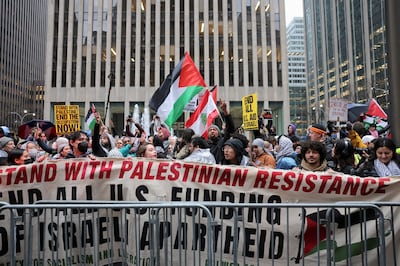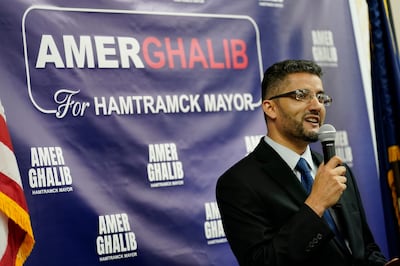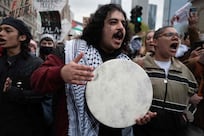It took more than a half century to strengthen the Arab-American identity and build organisations to meet the community’s needs. Today this work is under assault by those who seek to erase the gains made by these groups, fracture the community along sectarian lines, or silence their voices in US politics.
First, here is a bit of history.
Just six decades ago, there was no organised Arab-American community. There were people of Arab descent in America – most being descendants of First World War-era immigrants. As that wave had come primarily from Syria and Lebanon, the organisations they formed emphasised their country-specific or village identities. Palestinian clubs also brought together descendants of a few Palestinian villages.
As was the case with many other immigrant communities of this era, churches or mosques were the major institutions that organised the early immigrants of Arab descent.
After the freeze on immigration from the Arab world was lifted in the 1950s, the number of Arab immigrants increased and grew more diverse with respect to their countries of origin and religious affiliations. This change in the community’s composition, coupled with the growing population of children and grandchildren of those who had come prior to and during the First World War, accelerated the formation of an Arab-American identity.
The new and more diverse group of Arab immigrants and students who came to the US during this time brought with them ideas of political pan-Arabism that had gained currency across the Arab world.
The offspring of the earlier generation of immigrants came to embrace an Arab-American identity for different reasons. They were mobile, more integrated into American society, and coming of age in a period of American life when a number of ethnic identity movements were born. Instead of the narrower country, village or sect-based identities, they were drawn to those who shared their cultural heritage of language, music and even food. It was not ideology that brought them together, but a shared heritage.
Importantly, it was also Palestine – an issue that was a part of the community’s shared heritage, for two reasons.

First, it was understood to be an issue of a grave injustice done to the Palestinian-Arab people – many of whom had family in the US, with their numbers growing as a new wave of immigrants came after the 1967 War. A second reason was the discrimination and exclusion encountered by many Arab Americans – regardless of their country of origin – if they expressed sympathy for the Palestinian cause or even if they said nothing but were presumed to be pro-Palestinian because they were of Arab descent. The “injustice over there” was compounded by an “injustice over here”.
While the earliest major national organisations – the Association of Arab-American University Graduates and National Association of Arab Americans – were different in focus and composition, they shared a commitment to building a community based on a shared heritage and identity, including the issue of Palestinian rights. They de-emphasised divisions based on religious affiliation, national origin or immigrant/native-born status.
This effort to build a unified voice proved easy for some, yet challenging for others, especially during Lebanon’s long civil war. Some who fled that conflict brought their sect identity and grievances with them. Tension between those who principally identified as Lebanese, Palestinian or Syrian, or those who emphasised their Christian or Muslim identities also took a toll on the efforts to build a unified community.
Still, these organisations persisted.
In 1980, former senator James Abourezk and I launched the American-Arab Anti-Discrimination Committee to tackle negative stereotypes of Arabs in media and popular culture, and discrimination in all areas of life. The community was ready. As we travelled from city to city, the events we held brought into our fold tens of thousands of Arab Americans from every generation, country and religious affiliation.
I recall a 1981 dinner in Chicago of about 1,500. The local organiser began the night asking, in turn, for those from Lebanon, Palestine, Egypt, Jordan and down the line, to stand. He finished by noting how wonderful it was that we had brought together such a diverse crowd with a shared identity and unity of purpose.
After the devastation wrought by Israel’s bombardment of Beirut in 1982, we launched a project “Save Lebanon” to bring wounded Lebanese and Palestinian children to the US for treatment unavailable in Lebanon, given the destruction of West Beirut’s hospitals. After the children were sent to US hospitals and to the Arab-American communities that had offered to host them, I heard complaints from a few in the community. In one place they said, “we’re Palestinians and you sent us a Lebanese child [or vice versa]”. Or “we’re Christian and you sent us a Muslim boy [or vice versa]”.
Still, we persisted.
In the end, each of the communities fell in love with the children they hosted, and they embraced with pride what they had done for these innocent victims of war. As we went from city to city raising money to bring more children, I spoke about this embrace: “We brought the children here to heal them, but in the end, they healed us.”

During the next decade, Arab-American organisations witnessed several key developments: the Jesse Jackson presidential campaigns, the first to welcome Arab Americans into the political mainstream; the strengthening and growth of Arab-American institutions focusing on social services, preserving and promoting Arab history and culture; the intense pushback by major pro-Israel Jewish-American groups that called the Arab-American community a “fiction” and pressured others to exclude it; and the creation of the Arab-American Institute focusing on mobilising Arab Americans in all areas of US politics and public service – voter mobilisation, candidate support, and engagement in domestic and foreign policy deliberations.
The past three decades have witnessed both significant accomplishments and new challenges for the Arab-American community.
Arab Americans have emerged as an important constituency that is courted by political campaigns. They are being elected to federal, state and local levels of government. Social service and cultural agencies are caring for new immigrants and educating others about the community’s contributions to American life. Arab-American Heritage Month has become formally recognised by a presidential proclamation, and it is celebrated by governors and legislatures in almost every state, due in large part to the work of the Arab-America Foundation.
Of course, with this increased recognition has come increased pressure from those forces that seek to stymie the community’s growth and silence its voices. Its members have come to expect it and have steeled themselves to fight. More difficult to tackle has been the effort to divide the community.
Beginning with the Bush Jr administration, continuing into the Obama administration, and now accelerating during the Biden White House has been the effort to sectarianise the community by conflating Arab Americans with American Muslims, and then dividing outreach efforts to “Christian Arabs”. Because this effort has been initiated at the highest levels of government, it’s spilled over into the media and even some civil society initiatives.
The various national organisations representing Arab Americans have been united in rejecting this effort to erase the community’s non-sectarian, ethnic identity and drag it back to the days of division.
Arab Americans maintain the right to define themselves based on their history and their shared heritage. They remain unified in their efforts to fight against discrimination and political exclusion, and their shared commitment to fight for justice for Palestinians and a more balanced American foreign policy that promotes peace, security and prosperity for all of the countries of the Arab world.





